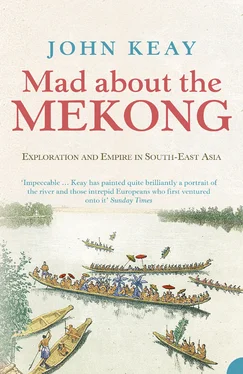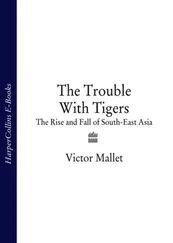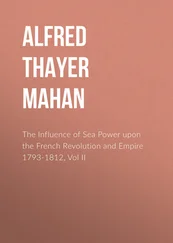Three years previously, in 1863, Lagrée had been deputed to pioneer France’s first push up from the Mekong Delta into Cambodia. His orders had been to explore the river’s course in that country and to persuade the Cambodian king to sign an exclusive defence treaty with France. On both counts he had succeeded. Siam’s (Thailand’s) prior claims to suzerainty over Cambodia’s King Norodom had been dismissed with a well-timed display of firepower, a treaty had been signed, and Lagrée had stayed on at Norodom’s court as France’s representative. That Cambodia had just become, in effect, a French protectorate was in no small measure thanks to le Commandant Doudart de Lagrée.
Encouraged by the thought that where he went, the tricolour had a way of following, it was Lagrée’s idea that the new Mekong expedition first sail across the Great Lake to Siem Reap and Angkor. Neither place was then part of Cambodia. In a protracted decline and fall to rival that of Rome, the Khmer empire had been disintegrating ever since Jayavarman VII completed the stalagmite of Janus-like statuary which is Angkor’s Bayon in the thirteenth century. Southern Vietnam, as it now is, including the Mekong Delta, had been lost by the Khmers over the next three hundred years; so had most of the middle Mekong and the Menam basin in Thailand; and in the late eighteenth century, as Vietnamese and Thais squeezed the Cambodian heartland ever harder, the eastern end of the Great Lake, including Angkor, had been annexed by Bangkok.
The French, as Cambodia’s new keepers, now disputed this cession of what they chose to call the ‘lost’ or ‘alienated’ Cambodian provinces. It helped that Angkorian scholarship provided cover for occasional visits and that Angkorian preservation provided a ready pretext for administrative interference. Lagrée had himself been in Angkor for several weeks in 1865 and again in early 1866. He had begun the mapping of the site and had commissioned translations of inscriptions which demonstrated that it was indisputably of Cambodian provenance. But Bangkok was unmoved; and in the course of these labours the climate had taken its toll of the indefatigable Lagrée. Suffering from a recurrent and acute form of laryngitis, he had formally requested home leave. Admiral de Lagrandière, the colonial governor in Saigon, suggested he defer the request, then asked him ‘out of the blue’, as he put it, to accept the leadership of the Mekong Exploration Commission. ‘Why not?’ replied Lagrée, and ‘I began to laugh.’ So, apparently, did the Admiral.
The joke, unexplained at the time, would soon turn decidedly sour. Laughter of any sort would not be much heard once the expedition got underway. To his companions Lagrée would remain an enigmatic supremo, neither overbearing nor unsympathetic but aloof, sometimes hesitant, often hard to hear (the laryngitis obliged him to whisper), and so weighed down by his responsibilities as to seem indifferent to the derring-do possibilities of the enterprise. Alternatively he was a pillar of strength and decency and ‘possessed of every psychological and moral quality needed for the success of the expedition’, as Garnier would put it. By implication, any fault lay not in his lofty character but in his state of health and in the more erratic calibre of his companions.
To reach the expedition’s Cambodian assembly point, Lagrée and his companions had already sailed from Saigon up through the Mekong Delta, crossing in the course of this three-hundred-kilometre voyage from French territory to Vietnamese territory to Cambodian. Then, as now, the political geography of the river was horribly confusing. As a rule major rivers – like the Yangtse, Mississippi, Amazon, Nile, Congo, Ganges – flow through just one or two countries. This is because a river basin tends to spawn the homogeneous and mutually dependent society which makes an excellent nucleus for a unitary state. Big rivers naturally make for big states, and so the Amazon integrates much of Brazil, the Yangtse much of China, and the Ganges much of India. Rivers, in essence, unite. They do not make good borders, however invitingly delineated on the map, nor do they lend themselves to being bisected by borders. On the contrary, ‘natural frontiers’ properly follow the outermost rim of a river’s watershed, however problematic the business of definition in such remote tracts.
To this rule the Mekong has long been a conspicuous exception. Historically it has spawned only one notable civilisation, that of Cambodia’s Khmers. But although Angkor, the Khmer capital, did indeed profit prodigiously from the freakish behaviour of the Mekong, it remained geographically tangential and politically indifferent to it. Likewise French Indo-China, while it would be postulated on the Mekong basin, would serve only to emphasise the incoherence of the lands which comprised that basin. For much of the river’s course the French would elevate it into an internationally recognised border which, in the second half of the twentieth century, would become that least permeable of all frontiers, an ideological divide. As the only substantial section of the Iron Curtain (or here sometimes the ‘Bamboo Curtain’) to be suspended along a riverbed, it cut most of south-east Asia in two, opposing the beneficiaries of a freer world on one bank to the ideologues of a fairer world on the other, and so turning every boat trip into an escape epic.
Today no fewer than six countries nestle along the river (China, Burma, Laos, Thailand, Cambodia, Vietnam); and for about a third of its length it still serves as an international frontier. Uniquely it has not, then, united the peoples strung along its course, nor encouraged much traffic and transit between them. As the Mekong Exploration Commission would quickly discover, there are good, indeed unassailable, reasons for this aberration.
But they are not apparent in the Delta. In fact, in its lowest reaches between Phnom Penh (at the apex of the Delta) and the South China Sea (as its eastward base), the Mekong bustles about its business most responsibly, smiling beneath colossal skies as if to deny a lifetime of upstream excesses. Brimming through low-lying farmland and slopping into innumerable channels and waterways, it here supports a vast population, fronts a galaxy of jaunty riverside towns, provides a carriageway for all manner of river craft, and generally exhibits the benevolent features associated with deltaic abundance. It is, in short, highly deceptive; and the Mekong Exploration Commission could be forgiven for being deceived.
Saigon itself, which in 1866 was just an enclave of French rule in an as yet uncolonialised Vietnam, is not actually on the Mekong Delta. It has its own river, the Donnai, to which it stands much as London to the Thames, the port of Saigon being the furthest point upriver to which ocean-going ships can conveniently sail. To reach the neighbouring Delta, you must today board a hydrofoil on the Saigon riverfront, skim down the Donnai’s leaden reaches past oilrigs and freighters to its estuary, and then turn right at the South China Sea.
Alternatively you can take a shortcut by making an earlier right turn into the Arroyo de Poste. An arroyo is a creek, a minor watercourse. This one, a linkage of wiggling tributaries and narrow canals, connects the sullen mangrove-fringed Donnai to a lusher landscape along the Tien Giang, the most northerly branch of the Mekong. It was the route taken in June 1866 by Canonnières 32 and 27 , the pocket-gunboats by which the French explorers sailed up to Cambodia; and according to Lieutenant Garnier, it was too well known to merit description.
In that photo taken at Angkor, Lieutenant Marie Joseph Francis Garnier is the man lolling at the opposite end of the group to le Commandant Doudart de Lagrée. A gaunt little figure with deep-set eyes, he sprawls on the steps like the others and is not obviously set apart from them. One leg, though, is drawn up so that the foot can rest on the equivalent ledge to that on which Lagrée is enthroned at the other end. The foot is making a point. Garnier, as one of the instigators of the expedition, its surveyor and hydrologist, and the most senior in rank after le Commandant , was officially Lagrée’s deputy and so, by implication, second-in-command. Indeed the Mekong Exploration Commission is commonly referred to as the ‘De Lagrée-Garnier Expedition’ and sometimes, more controversially, as just the ‘Garnier Expedition’. Garnier would write both the official account of it and the best-known of the personal accounts. He would also collect all the medals and the plaudits. When Lagrée’s supporters objected, Garnier would respond with double-edged testimonials to his superior. ‘He was for us less a commandant than a father,’ he would write.
Читать дальше












